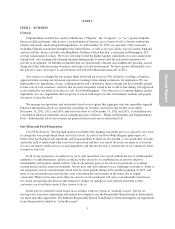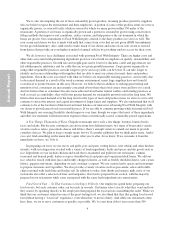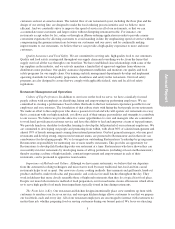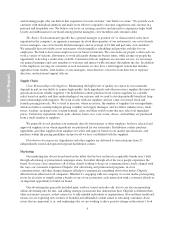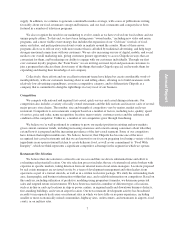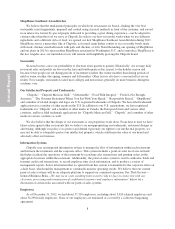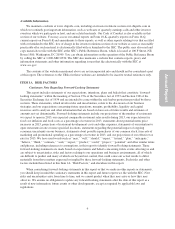Chipotle 2012 Annual Report Download - page 15
Download and view the complete annual report
Please find page 15 of the 2012 Chipotle annual report below. You can navigate through the pages in the report by either clicking on the pages listed below, or by using the keyword search tool below to find specific information within the annual report.
ingredients and a different style of food, we opened ShopHouse Southeast Asian Kitchen during 2011.
Notwithstanding our opening of ShopHouse and our plans in 2013 to open another ShopHouse restaurant in
Washington D.C. and to introduce ShopHouse to the Los Angeles area, our immediate focus will remain on
thoughtfully growing the Chipotle brand. As a result, we do not expect ShopHouse to contribute to our growth in
a meaningful way for at least the next several years, and we may determine not to move forward with any further
expansion of ShopHouse. This might limit our overall growth over the long term.
Our failure to manage our growth effectively could harm our business and operating results.
As described elsewhere in this report, our plans call for a significant number of new restaurants. Our
existing restaurant management systems, financial and management controls and information systems may be
inadequate to support our expansion. Managing our growth effectively will require us to continue to enhance
these systems, procedures and controls and to hire, train and retain general managers and crew. We also are
continuing to attempt to improve our field management in an effort to develop additional top-performing general
managers more quickly. We may not respond quickly enough to the changing demands that our expansion will
impose on management, crew and existing infrastructure, and changes to our operating structure may result in
increased costs or inefficiencies that we cannot currently anticipate. Changes as we grow may have a negative
impact on the operation of our restaurants, and cost increases resulting from our inability to effectively manage
our growth could adversely impact our profitability. We also place a lot of importance on our culture, which we
believe has been an important contributor to our success. As we grow, we may have difficulty maintaining our
culture or adapting it sufficiently to meet the needs of our operations. Our failure to foster and maintain our
corporate culture could also harm our business and operating results.
Risks Related to Operating in the Restaurant Industry
Changes in food and supply costs could adversely affect our results of operations.
Our profitability depends in part on our ability to anticipate and react to changes in food and supply costs.
Like all restaurant companies, we are susceptible to increases in food costs as a result of factors beyond our
control, such as general economic conditions, seasonal fluctuations, weather conditions, global demand, food
safety concerns, generalized infectious diseases, fluctuations of the U.S. dollar, product recalls and government
regulations. The cost of many basic foods for humans and animals, including corn, wheat, rice and soy oil, has
increased markedly in some years, resulting in upward pricing pressures on almost all of our raw ingredients
including chicken, beef, tortillas and rice, increasing our food costs. Food prices for a number of our key
ingredients escalated markedly at various points during 2012 and we expect that there will be additional pricing
pressures on some of those ingredients, including beef, chicken, pork, cheese and sour cream during 2013. We
could also be adversely impacted by price increases specific to meats raised in accordance with our sustainability
and responsibility criteria or other food items we buy as part of our Food With Integrity focus, the markets for
which are generally smaller and more concentrated than the markets for commodity food products. Weather
related issues, such as freezes or drought, may also lead to temporary spikes in the prices of some ingredients
such as produce or meats. Any increase in the prices of the ingredients most critical to our menu, such as
chicken, beef, cheese, avocados, beans, rice, tomatoes and pork, would adversely affect our operating results.
Alternatively, in the event of cost increases with respect to one or more of our raw ingredients, we may choose to
temporarily suspend serving menu items, such as guacamole or one or more of our salsas, rather than paying the
increased cost for the ingredients. Any such changes to our available menu may negatively impact our restaurant
traffic and comparable restaurant sales.
Our business could be adversely affected by increased labor costs or difficulties in finding the right
employees for our restaurants and the right field leaders.
Labor is a primary component of our operating costs, and we believe good managers and crew are a key part
of our success. We devote significant resources to recruiting and training our general managers and crew.
Increased labor costs due to factors like additional taxes or requirements to incur additional employee benefits
costs, including the requirements of the Patient Protection and Affordable Care Act (discussed further under
13
Annual Report


